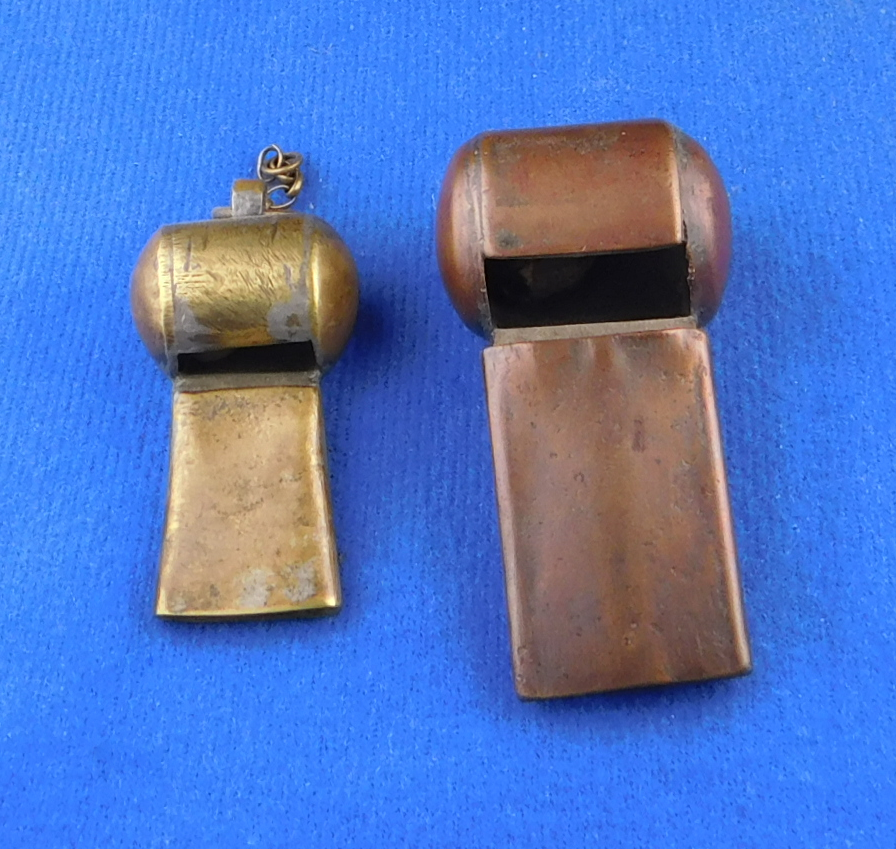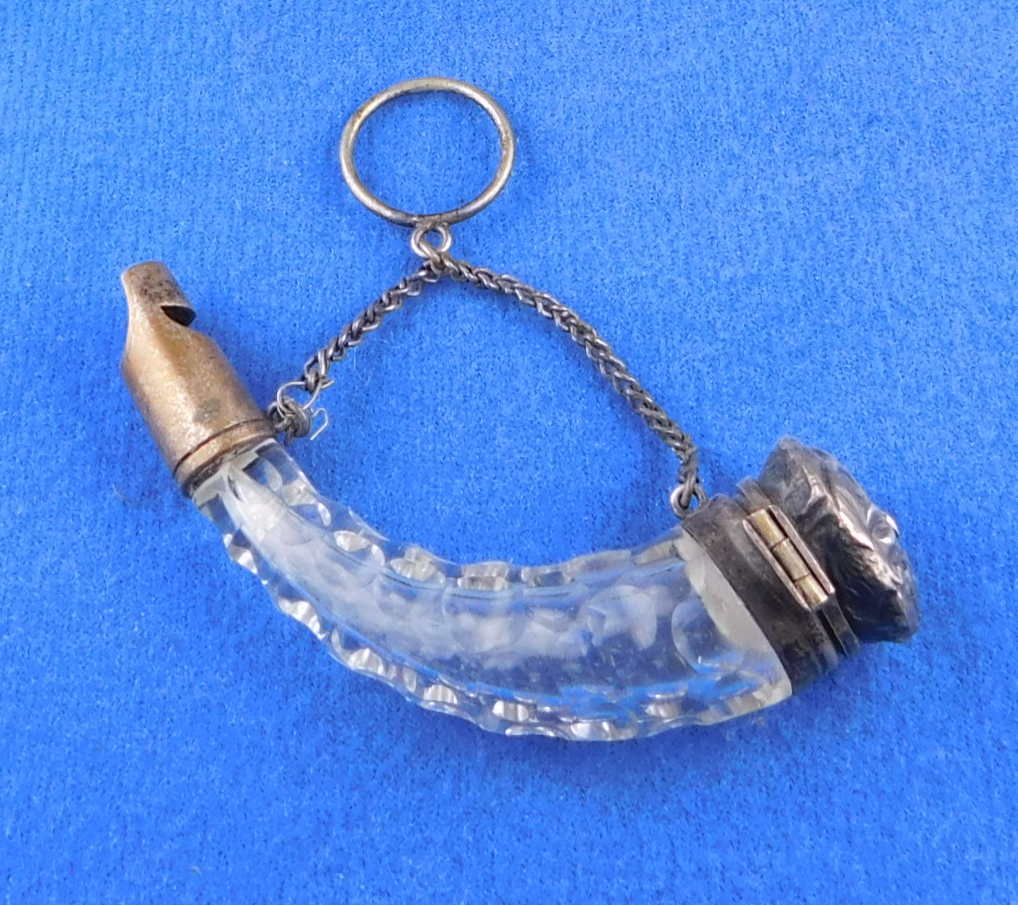Whistory
Looking backwards and reconstructing history is always a challenge, especially when lacking records for the Ward-DeCourcy transition. Typifying this is the dearth of information on anything to do with Henry Arthur Ward ironically as he was a major contributor to manufacturing whistles in the years prior to 1900 . Now couple this with Alfred De Courcy whose records were burned by family members decades after he passed (1969).
Why are these two companies (Ward-DeCourcy) important for whistle research?
It appears that there was an ongoing relationship with these two companies from Birmingham, UK. This SPOTLIGHT attempts to rebuild some pertinent facts. Hopefully more will come to light. Our focus of attention is the period between 1903 and 1906 because that is when it appears that the baton was handed off to Alfred De Courcy with Ward’s whistle making.
Henry Arthur Ward was the patriarch for most of the company’s pre 1900 history, his passing away in 1903. Thus, leaving the company to his son, Arthur Henry Ward who keeps the company open, it continuing on for many decades ( but without whistles ). At an unknown point post HAW’s death, Arthur ( i.e. AHW ) turns to Alfred De Courcy who takes over whistle production, notably using his own patent – 3725, 1906 — along with the known Ward stamps and we no longer see Ward whistles.
A Lilly catalog reputedly dated 1909 advertises at least 10 Ward whistles, mainly round whistles. Were these whistles leftover as shelf stock from a bygone era? Unlikely. Or should this catalog in fact be dated earlier? Indeed, the thin wall siren pictured model # 45, was patented in 1895, admittedly however the boatswain pipes partially pictured, model # 31, appear to be circa 1900. Regardless, an earlier date of the catalog seems called for.
Looking back to when Alfred De Courcy left Hudson’s in 1888, records show that De Courcy was supplying whistles to Ward circa 1889. This was testified in court in 1907, claimed by Arthur Henry Ward, Henry Arthur Ward’s son, further showing a working relationship over a 15-year period.
What are some patterns seen that substantiate a Ward-DeCourcy transition period?
In studying known whistles, the word STANDARD was used by both Ward and De Courcy and is a common denominator during this transition period, as well as the word SCOUT.
STANDARD was coined by HAW and transitioned through his son’s tenure and into De Courcy’s whistles — for a time at least. SCOUT parallels this pattern, yet the question arises, if SCOUT meant something different than the scouting movement circa 1909. Perhaps it was at first used for Police and Fire and then later for the scouting movement itself and the term transitioned when Baden Powell adopted its use for the scouts ( i.e. boy, girl, sea ) .
Another theme that transitioned from Ward to De Courcy was The Police or Fire stamp, however there were also other manufacturers targeting this market ( i.e. Yates, Hudson ). Ward and De Courcy both sought this market; however, Ward had a model that matched Yates and was a pre-1900 model. Gilchrist reports this model in a side note and picture in CPWs page 85, an advertisement for such a whistle was placed in 1905 ( two years after HAWs death ) which seems late in the game, yet sometimes older model pictures were used in catalogs and advertisements.
During this nebulous time, the few years of 1903 to 196, it appears that Ward whistles had dropped off dramatically and De Courcy whistles were heading for a peak, with Alfred and Edgar De Courcy ( his brother ) just starting patents in 1905 at their newly founded shop.
Additionally, Arthur Henry Ward testifies in Alfred’s behalf against the efforts of Hudson to procure the trade name of Thunderer in court in 1905, only 2 years after HAWs death.
A Question Arises Regarding Ward-DeCourcy
A pertinent question is whether the very heavy, even bulky tube-shaped whistles, were made by the patriarch or later by his son. This whistle also may turn out to be a transitionary whistle model between the father and the son, as the quality is certainly significantly less than previous models, including the material used, described by Gilchrist as cast ‘white metal’.
It does however utilize a design characteristic ( the top cap and ring ) of the model stamped Standard Police or Fire whistle along with Henry Arthur Ward name fully on it. No heavy model has surfaced with HAWs initials or name stamped on it.
Whistle Classification
| Category | tubular round escargot |
| Order | Henry Arthur Ward Arthur Henry Ward Alfred De Courcy |
| Type | police fire police or fire scouts |
| Class | steel white metal nickel plated brass steel and brass |
| Subclass |
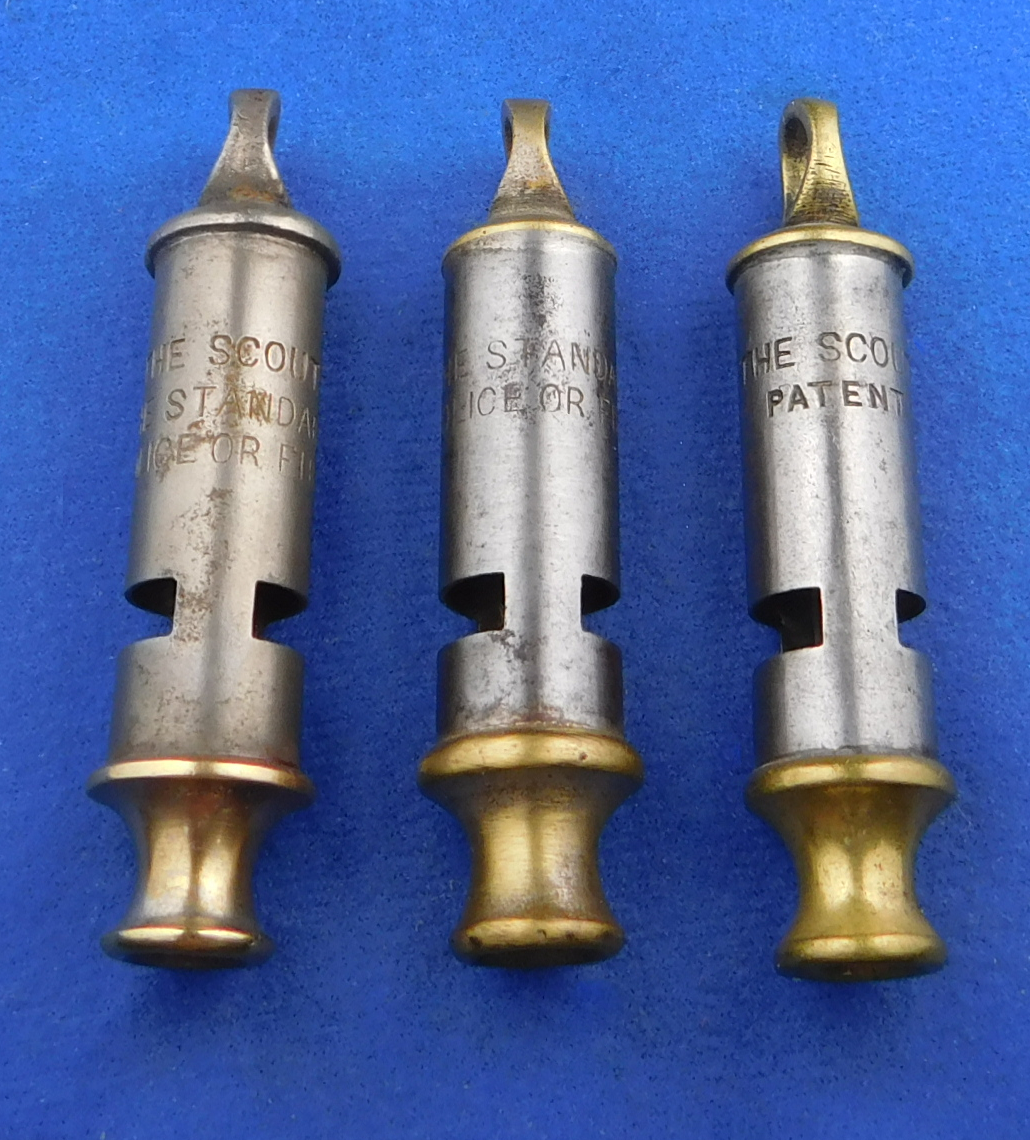
Whistle Archeology
A court report that summarizes the challenge met in 1907 between Hudson and De Courcy over the registration of the name Thunderer. It was brought out that Ward was ordering Thunderer stamped whistles from Alfred De Courcy just one year after he left Hudson to go on his own in 1898.
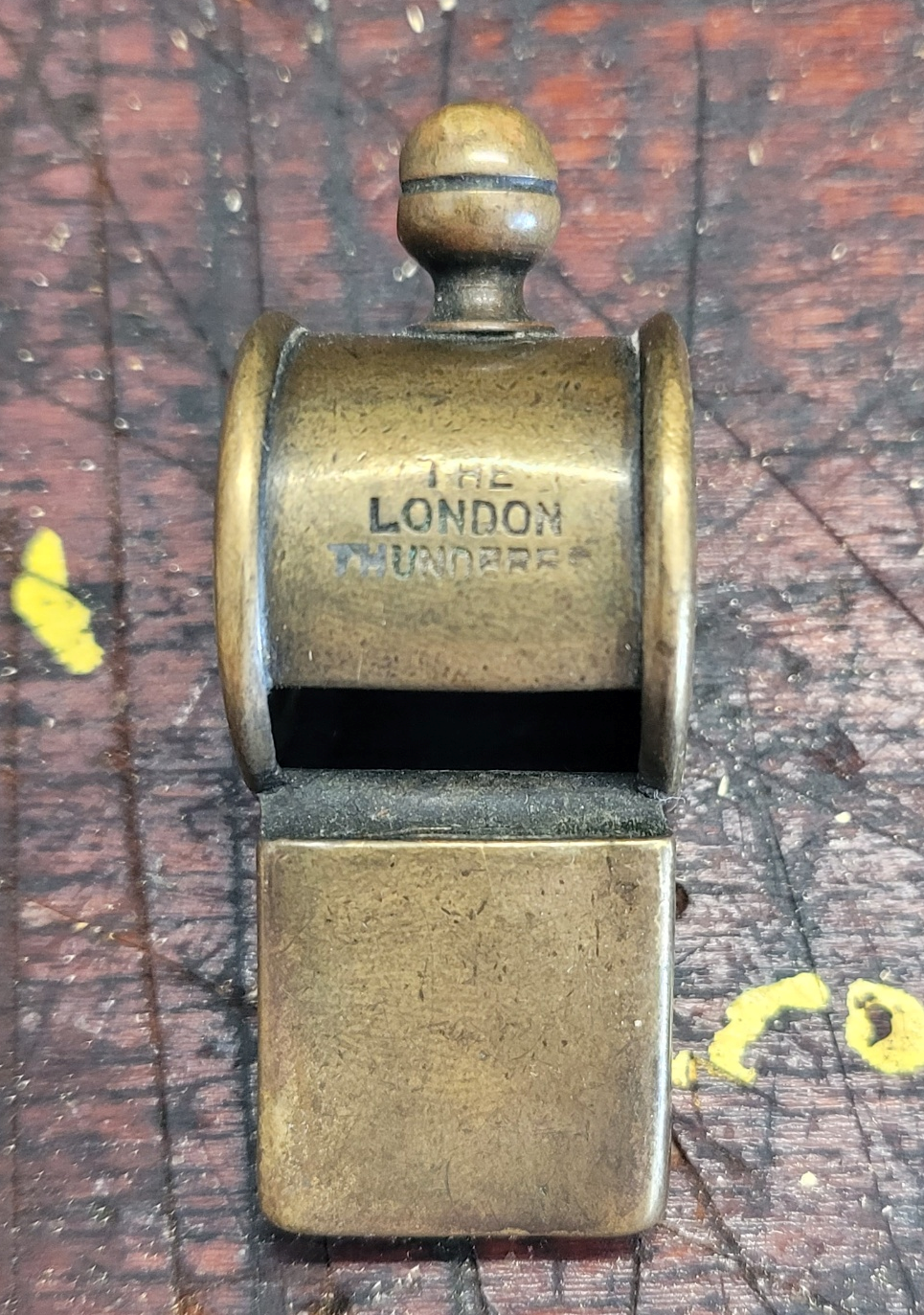
Photo Courtesy of J. Guttridge
CPWs reports that De Courcy is listed in trade directories from 1899 to 1903 as a whistle maker at 28 ½ Mary Street, Birmingham.
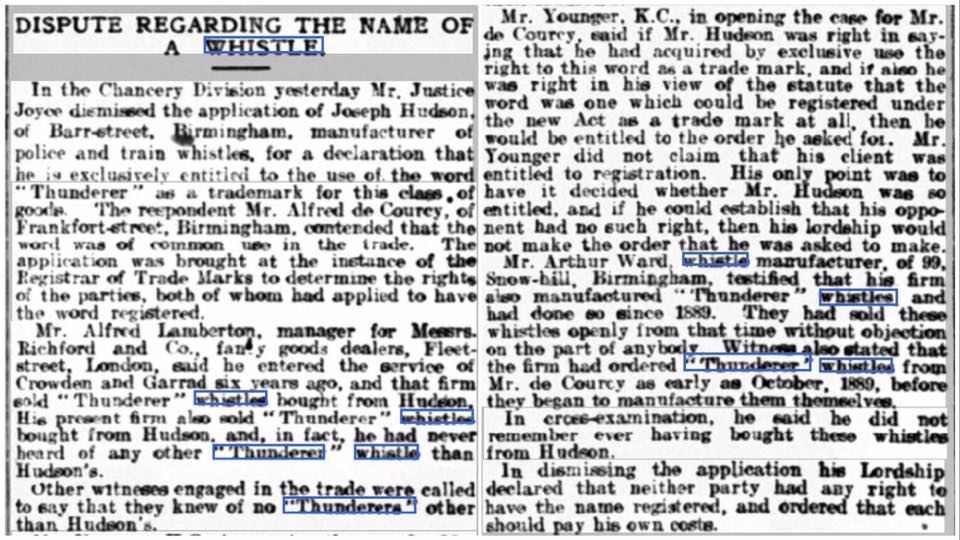
Two significant catalog pages, one from Lilly ‘reputedly’ dated 1909. One from Ward dated 1879. Additionally, a snippet of an advertisement showing a pre-1900 model dated 1905.
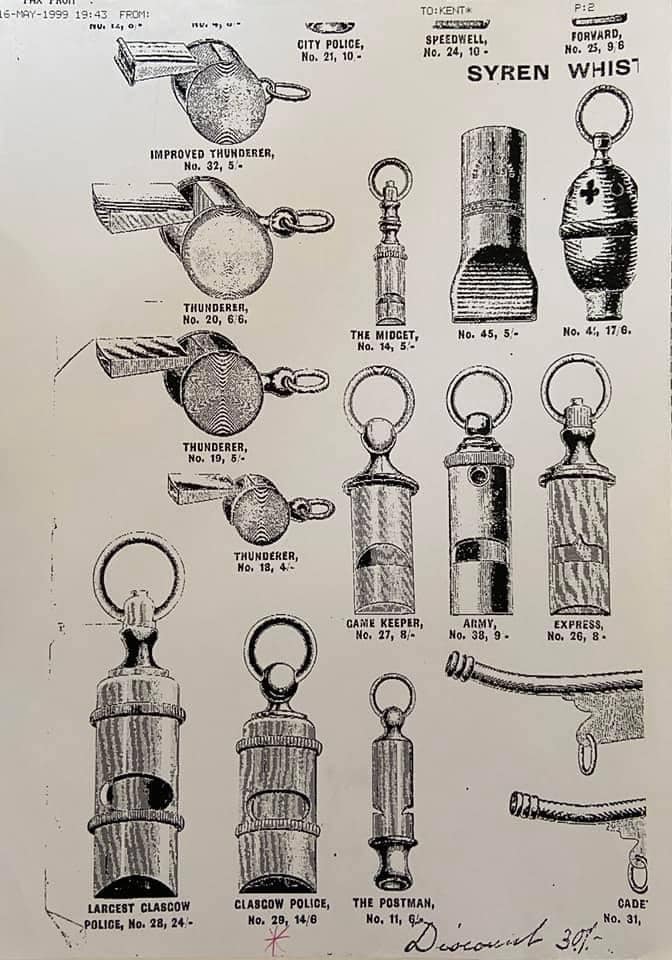
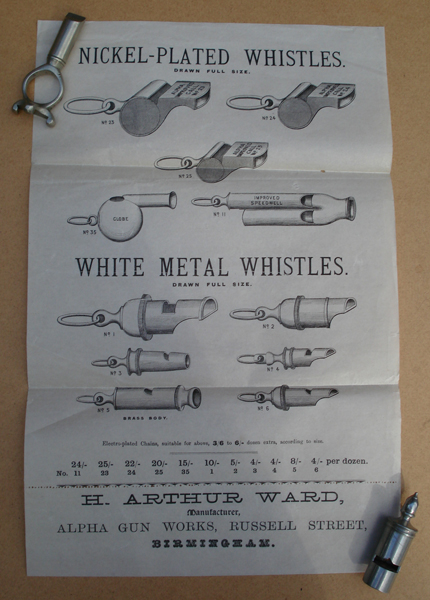
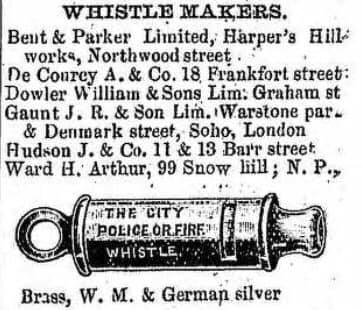
Whistology
We will now look at a procession of whistles estimated from the earliest, circa pre 1900 to the more recent, circa 1905.
We will be especially looking for these things.
- The wording used in the earliest stamps and the later stamps made by two different companies, the second adopting the first’s
- The construction proving De Courcy fully adopting the earlier stamp.
- “The Standard Police or Fire’ was coined by Ward and adopted by De Courcy.
- Scout used in conjunction with Police or Fire started by Ward, adopted by De Courcy
Clearly the larger model has Henry Arthur Ward stamped on it.
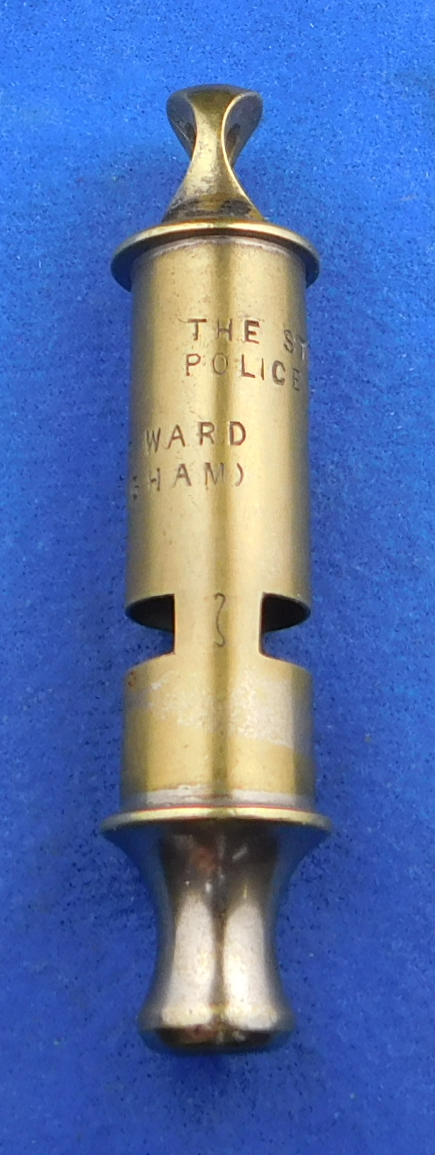
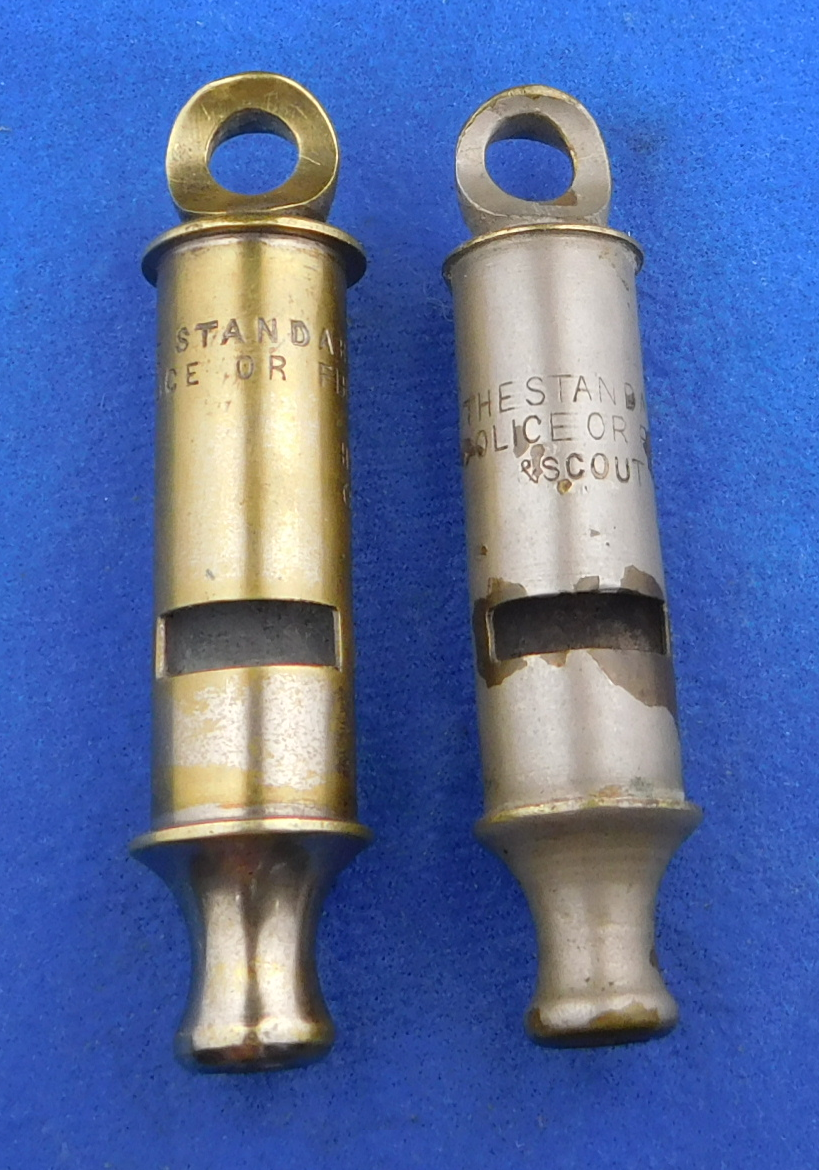
Compare the two attributed to HAW
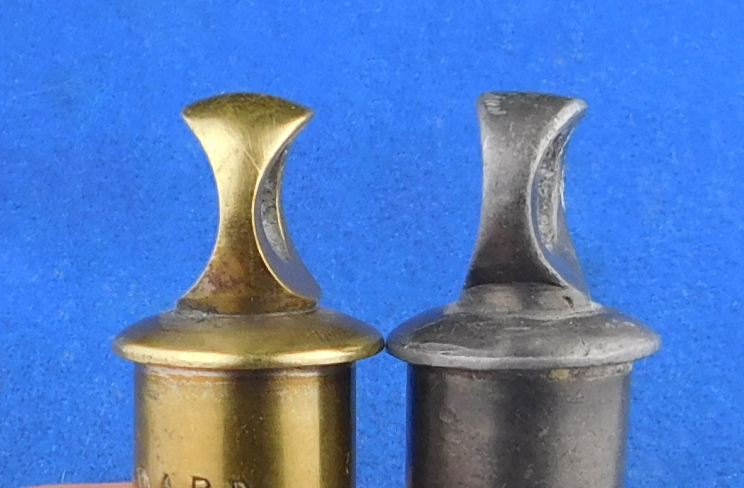
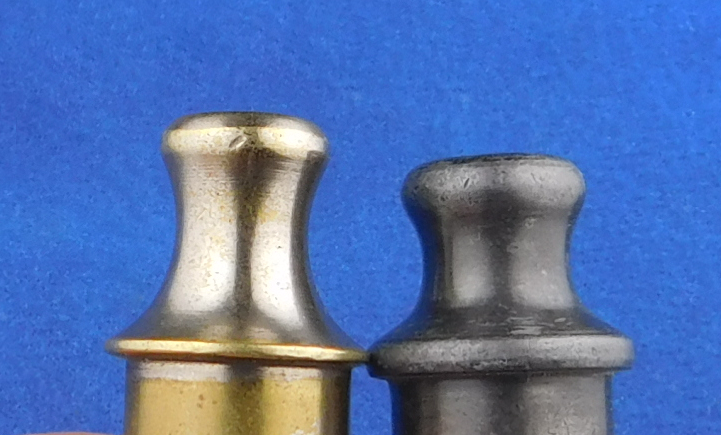
1st whistle is clearly by HAW
2nd whistle rarely seen stamp of later model attributed to HAW
3rd whistle also attributed to HAW
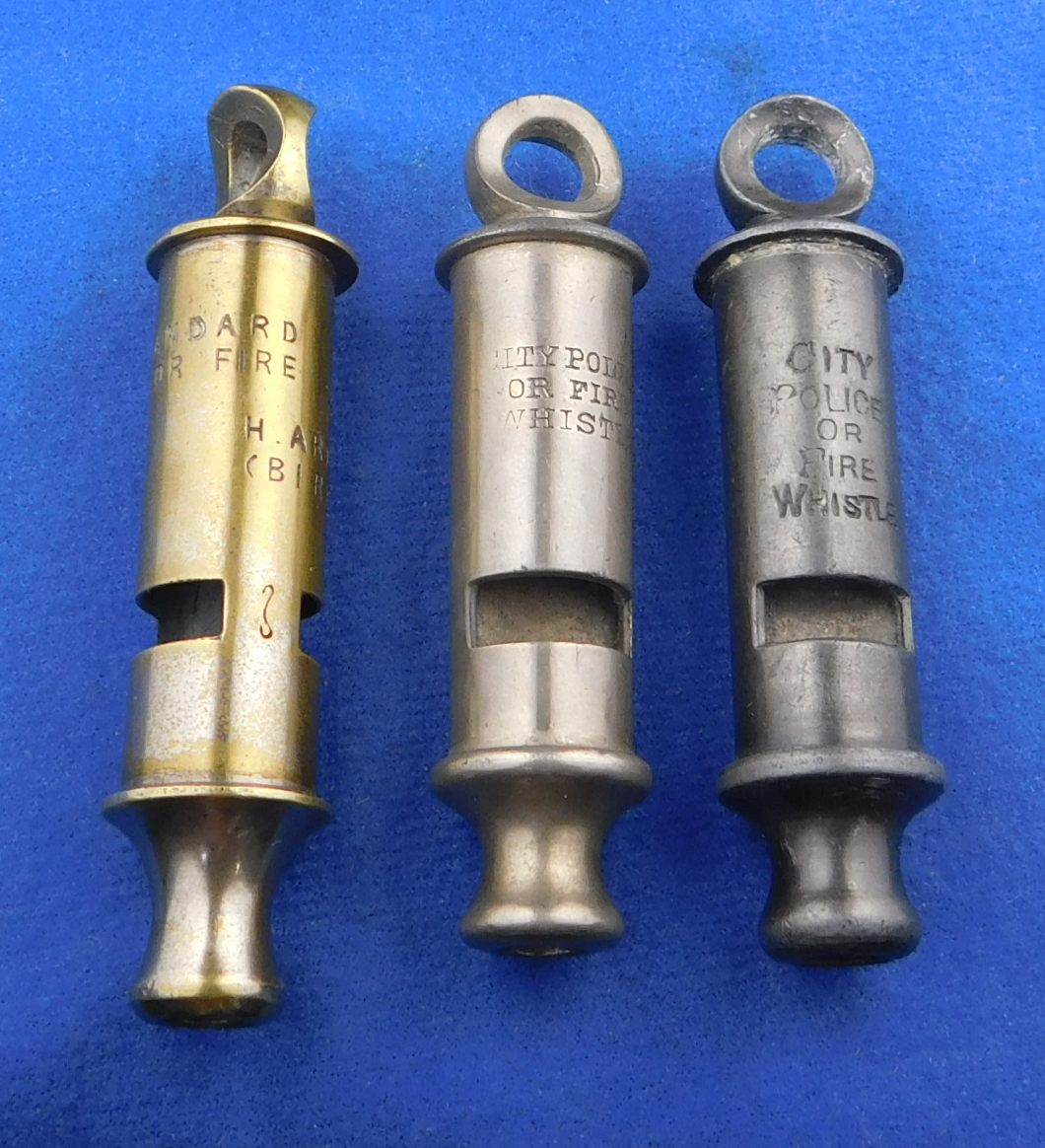
When was the word scout first used on whistles and what was its meaning?
The question arises if it was for the boy scout movement under Baden Powell, which would have been 6 years after HAWs passing ? Or was scout used for a different purpose in conjunction with Police or Fire ?
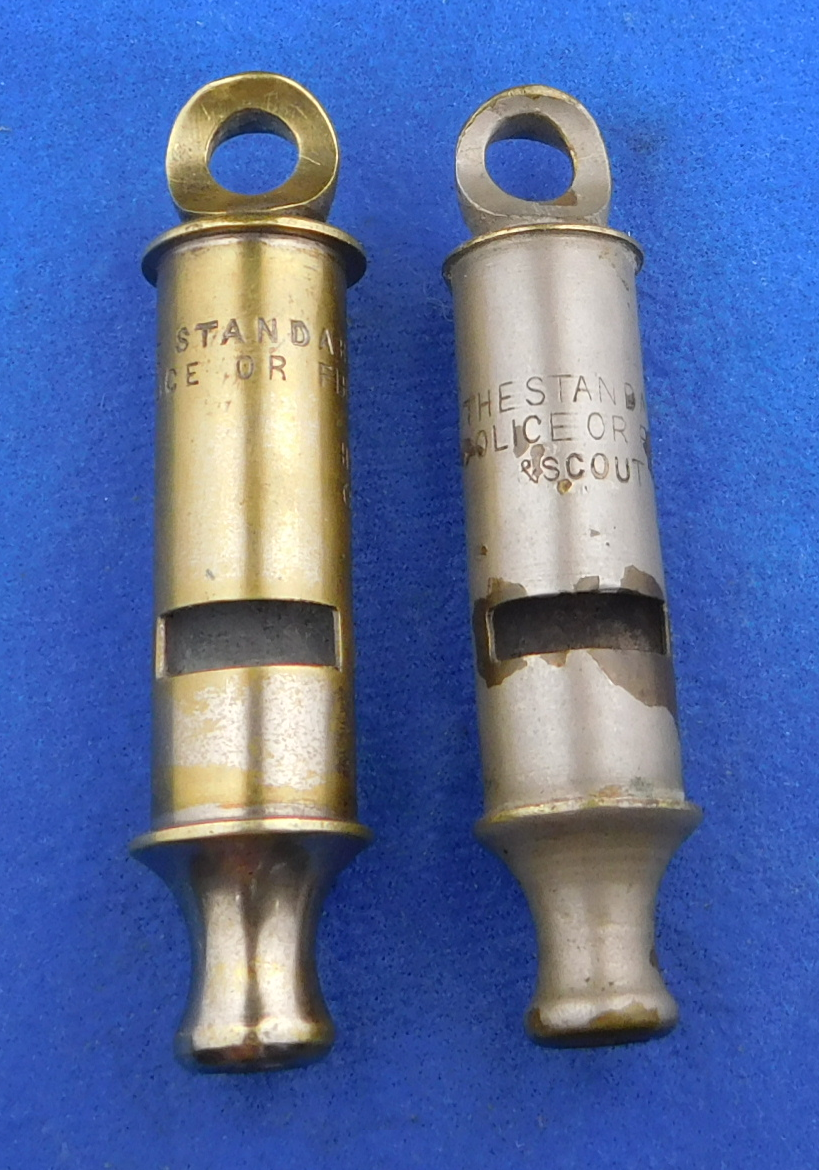
Left to right:
- Henry Arthur Ward stamped on The Standard Police or Fire
- The Standard Police or Fire & Scout – early body matches #1
- A different model ( attributed to HAW ) but by , HAW or AHW ?
- The Scout The Standard Police or Fire – De Courcy 1905 patented tine
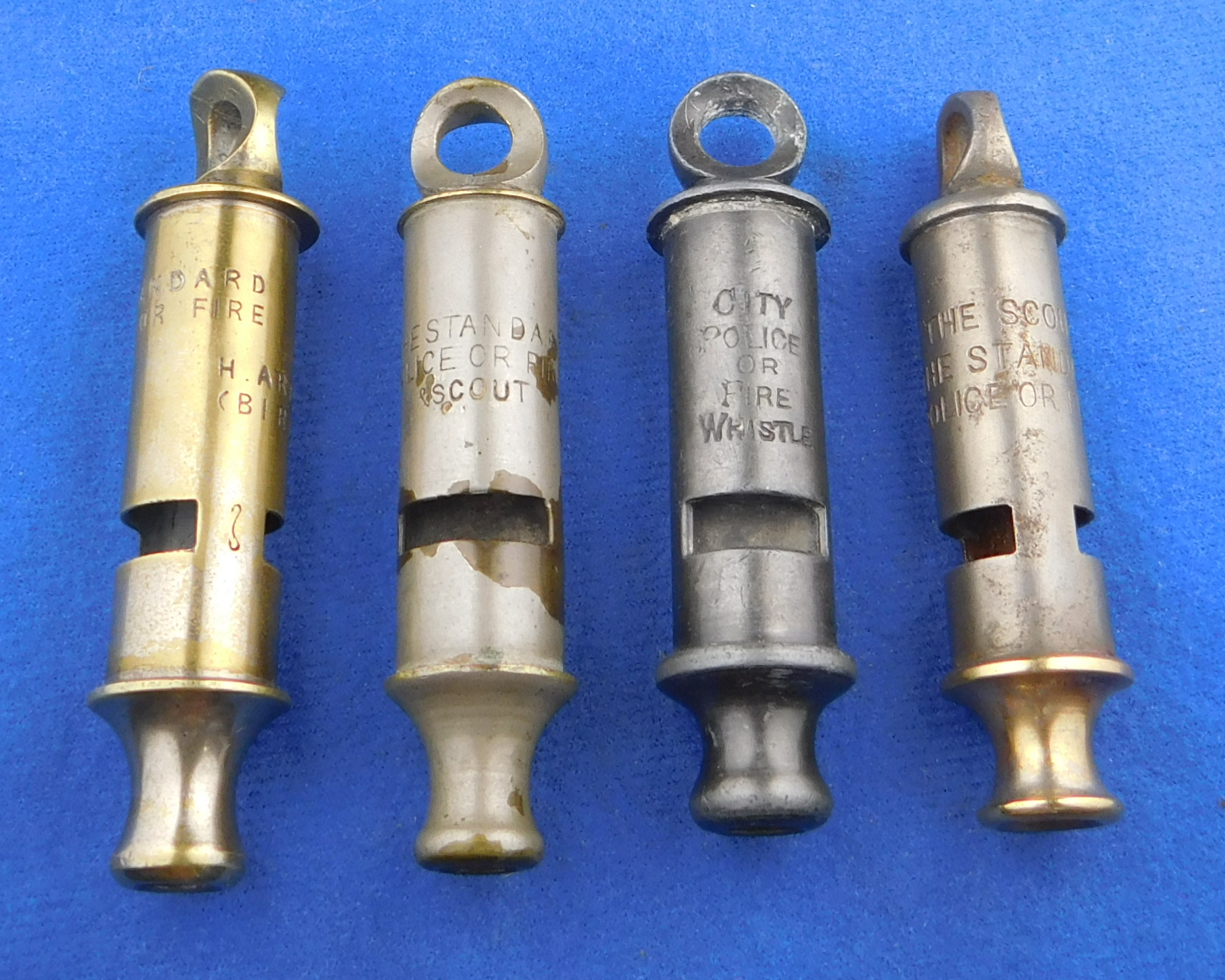
In 1905, only two years after HAWs death, Arthur and Alfred united in their opposition to Joseph Hudson in court over the long-used public domain name ‘Thunderer’, which they had shared use of since 1889.
By 1906 Alfred De Courcy was using his 1906 patented whistle designs, using the stamp language previously used by Henry Arthur Ward.
So, while Arthur Ward was still operating his company, now Alfred was making whistles with his father’s original stamp language.
All three whistles are made to patent 3725 using a needle tine design of 1906.

Conclusions
Clearly a transition was made of whistle making from Ward’s company to De Courcy’s company.
A significant drop of quality occurred that seems to follow the pictured Standard Police or Fire & Scout stamp unearthed on a whistle closely matching ones with HAWs name on them.
It was followed by a lesser quality heavy, almost bulky model. This possibly occurs during the period of 1903 to 1906.
The use of the word scout needs to be researched further, as it appears preceding the scout movement ( Baden Powell first published January 24, 1908 ) by several years.
The connection between Police or Fire and Scouts remains enigmatic.
TWG
Posted March 23, 2023
Bibliography:
Collecting Police Whistles and Similar Types, Gilchrist and Topman
More Whistles, Gilchrist
TWG Reference Collection
http://www.troop-649.org/history-of-the-boy-scouts.html
© – All photos with blue background property of The Whistle Gallery reference collection. Please contact The Whistle Gallery for permission of use of any website content. Spotlight articles are copyrighted. Please contact The Whistle Gallery for permission of use of any website or Spotlight article material written or otherwise. Use of photos without authorization is prohibited.
